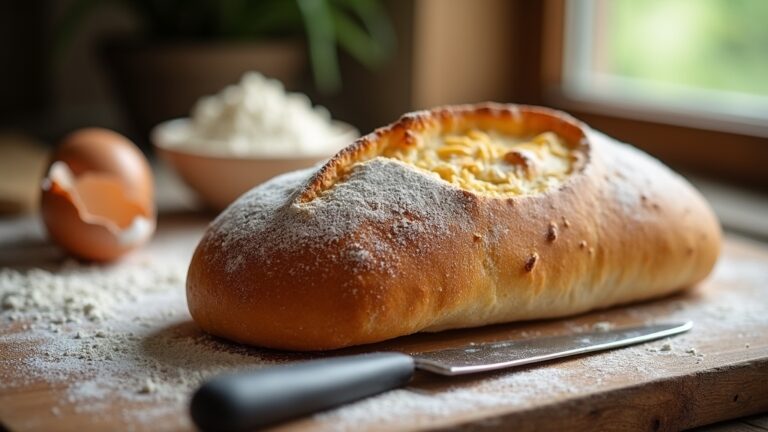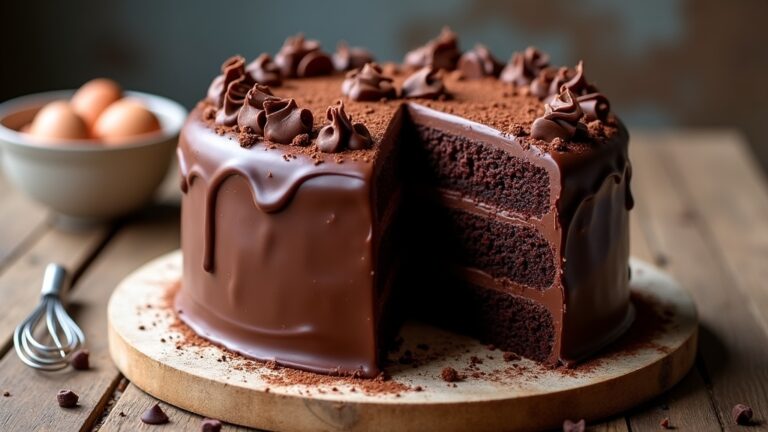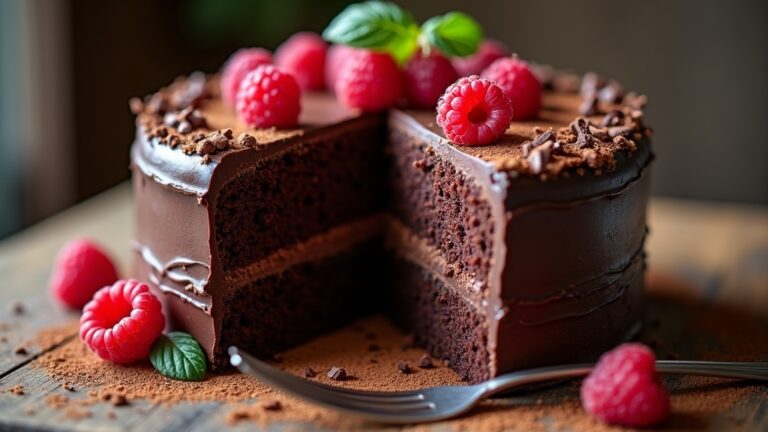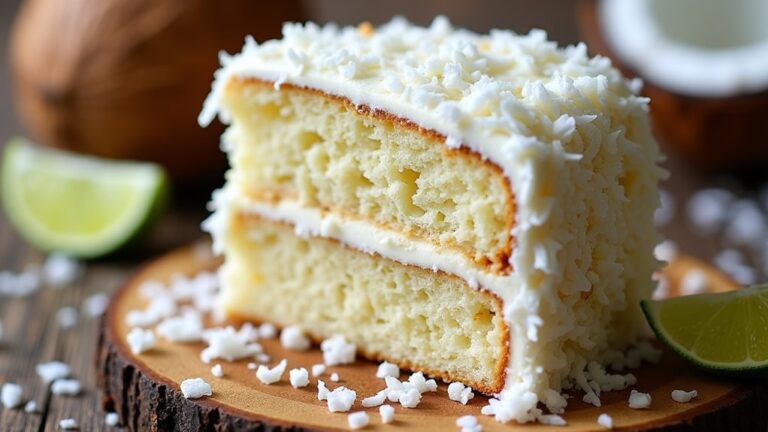White Cake Recipe
If you’re looking to make a classic white cake, start by mixing flour, baking powder, and salt. Cream together butter and sugar, then fold in egg whites for a fluffy texture. Don’t forget the vanilla! Pour your batter into prepared pans and bake at 350°F until golden. This versatile cake is perfect for any occasion, and you can add your favorite fillings and frostings. Stick around to uncover some delightful variations and presentation ideas!
Contents
History
The history of white cake is as rich as its flavor, originating from the desire to create a light, airy dessert that symbolizes purity and celebration. You’ll find its cake origins trace back to the 19th century in America, where it became a staple at weddings and special occasions. Its delicate texture and color made it a favorite among bakers, reflecting the cultural significance of joy and unity during celebrations. As you savor each bite, remember that this dessert represents more than just sweetness; it embodies a tradition of togetherness and festivity. Over the years, white cake has evolved, adapting to various cultural influences while maintaining its classic charm, inviting you to indulge in a piece of history with every slice.
Recipe
White cake is a classic dessert that is loved for its delicate texture and subtle sweetness. This versatile cake serves as the perfect base for a variety of frostings and fillings, making it an excellent choice for celebrations or simply as a delicious treat to enjoy at home. Whether you’re baking for a birthday, a wedding, or just because, a well-made white cake can elevate any occasion.
To achieve that light and fluffy consistency that white cake is known for, it is important to use high-quality ingredients and follow the mixing techniques closely. The key to a successful white cake lies in the creaming of the butter and sugar, which incorporates air into the batter, giving it a tender crumb. This recipe will guide you through creating a delightful white cake that is sure to impress your family and friends.
Ingredients:
- 2 ¾ cups all-purpose flour
- 2 ½ teaspoons baking powder
- ½ teaspoon salt
- 1 cup unsalted butter, softened
- 2 cups granulated sugar
- 4 large egg whites
- 1 tablespoon vanilla extract
- 1 cup whole milk
Instructions:
Preheat your oven to 350°F (175°C) and grease two 9-inch round cake pans. In a medium bowl, whisk together the flour, baking powder, and salt; set aside. In a large mixing bowl, cream the softened butter and sugar together until light and fluffy, about 4-5 minutes. Add the egg whites one at a time, mixing well after each addition, followed by the vanilla extract. Gradually add the flour mixture to the wet ingredients, alternating with the milk, and begin and end with the flour mixture. Stir until just combined, taking care not to overmix. Divide the batter evenly between the prepared cake pans and smooth the tops. Bake for 25-30 minutes or until a toothpick inserted into the center comes out clean. Allow the cakes to cool in the pans for 10 minutes before transferring them to a wire rack to cool completely.
Extra Tips:
To make sure your white cake comes out perfectly every time, make sure all your ingredients are at room temperature before mixing. This will help create a smooth batter and even texture. Additionally, if you want to enhance the flavor, consider adding a bit of almond extract along with the vanilla. For a more decorative touch, you can frost the cake with a classic buttercream or a light whipped cream and top it with fresh fruits or edible flowers. Finally, always store your cake in an airtight container to keep it fresh and moist.
Cooking Steps
Now that you have your ingredients ready, it’s time to bring your white cake to life. Start by preheating your oven to 350°F, setting the stage for that perfect bake. As you mix your dry ingredients together, the anticipation of a delicious cake begins to build!
Step 1. Preheat the Oven to 350°F
Before you plunge into mixing your cake batter, it’s vital to preheat your oven to 350°F. This oven temperature is the sweet spot for achieving that perfect rise and golden crust. As your oven warms, it creates an inviting environment where the magic of baking happens. Don’t rush this step—starting with a properly heated oven is one of the essential baking tips that can make or break your cake. You want those ingredients to sizzle and meld together beautifully, enhancing flavors and textures. Once the oven signals it’s ready, you’ll be set to pour in your batter and let the transformation begin. So, take a moment to enjoy the anticipation; deliciousness is just around the corner!
Step 2. Mix Dry Ingredients Together
With your oven preheated and ready, it’s time to gather your dry ingredients for that perfect white cake. Start by measuring sugar, making sure it’s light and fluffy. Next, grab your flour and sift it into a large mixing bowl. Sifting flour not only removes lumps but also aerates it, giving your cake a delicate texture. Combine the sugar and flour, then add baking powder and a pinch of salt for balance. Whisk them together until well blended; this simple step guarantees even distribution of the leavening agents, essential for that rise you’re after. Once everything’s mixed, you’ll be ready to move on to the next step in your cake-making adventure. Enjoy this moment—baking is all about freedom and creativity!
Step 3. Add Wet Ingredients Gradually
As you prepare to add the wet ingredients, remember that doing this gradually will help create a smooth batter without any lumps. Start by pouring a small amount of your wet mixture into the dry ingredients, stirring gently as you go. This wet mixing technique guarantees that your ingredient ratios remain balanced, allowing the flavors to meld perfectly. Continue this process, adding the wet ingredients in increments, and watch as the batter transforms into a silky consistency. Don’t rush—taking your time here means you’ll avoid clumps and achieve that light, airy texture you crave. With each addition, embrace the freedom of creating something delicious; your patience will pay off in the form of a beautifully baked white cake!
Step 4. Fold in Egg Whites
Now that your batter is smooth and well-combined, it’s time to fold in the egg whites. This step is vital for achieving that light, airy texture you crave. Start by taking a generous scoop of the beaten egg whites and gently adding it to your batter. Using a spatula, employ a technique explained as “folding.” This means you’ll lift the batter from the bottom and gently turn it over the egg whites, repeating until just combined. Avoid vigorous stirring; you want to keep as much air in those egg whites as possible. The magic happens here, creating a cake that rises beautifully and feels fluffy. Enjoy the freedom of baking as you embrace this essential step!
Step 5. Pour Batter Into Pans
Gently pour the batter into your prepared cake pans, ensuring an even distribution for consistent baking. As you do this, take a moment to appreciate the smooth, glossy texture of your batter—it’s a reflection of your baking techniques. Use a spatula to help guide the batter, especially in the corners, to avoid any lumps. Once you’ve filled the pans, you can give them a gentle tap on the counter to eliminate air bubbles that could affect the cake’s rise. If you’re planning on cake layering, make sure the batter is level, which will create a beautiful base for stacking. Now, it’s time to bake—your white cake is one step closer to perfection!
Nutritional Guide
When you indulge in a slice of white cake, understanding its nutritional content can enhance your enjoyment and help you make informed choices. This cake, often made with simple yet delicious ingredients, offers both caloric content and ingredient benefits that you should appreciate.
Here’s a quick look at the nutritional aspects:
| Nutrient | Amount per Slice |
|---|---|
| Calories | 250 |
| Sugars | 20g |
| Fat | 10g |
| Protein | 3g |
The caloric content can vary based on your recipe, while ingredient benefits include energy from carbohydrates and pleasure from flavors. Enjoying your cake mindfully allows you to savor each bite while being aware of what you’re consuming.
Final Thoughts
As you savor the last bite of your white cake, it’s clear that this sweet treat is more than just a dessert; it’s a celebration of flavors and textures. Whether you’re baking for a special occasion or simply indulging yourself, mastering this recipe opens the door to countless variations. Here are some baking tips to elevate your experience:
- Experiment with different extracts like almond or lemon for a unique twist.
- Incorporate fruits or nuts to add texture and flavor.
- Try layering with various fillings, like whipped cream or fruit preserves.
- Decorate with fresh flowers or seasonal fruits for a stunning presentation.
- Consider gluten-free or vegan alternatives for more inclusive options.
Enjoy the freedom of creativity in your baking journey!
Frequently Asked Questions
Can I Substitute Egg Whites for Whole Eggs in This Recipe?
You can substitute egg whites for whole eggs, but be aware it’ll change the cake texture. Egg whites create a lighter, fluffier cake, so adjust your expectations for richness and moisture in your final product.
What Type of Flour Is Best for White Cake?
When making a delicate white cake, cake flour’s fine texture gives you that soft, airy crumb. While all-purpose flour can work, it won’t achieve the same lightness. Choose cake flour for the best results!
How Can I Make My White Cake More Moist?
To make your cake more moist, try using buttermilk for added richness. Adding sour cream enhances moisture and creates a tender crumb, making every bite deliciously satisfying. Your cake will be irresistibly soft and flavorful!
Can I Use a Different Type of Frosting?
Why stick to one frosting when you can explore? You can definitely use Chocolate Ganache or Cream Cheese frosting for a delightful twist. Each adds unique flavor and richness, giving your cake a fresh, exciting experience!
How Long Can I Store Leftover White Cake?
You can store leftover cake for up to four days in the fridge. For longer freshness, use freezing methods—wrap it tightly in plastic. Storing tips like these guarantee your cake stays delicious and ready when you are!
Conclusion
As you savor each bite of your homemade white cake, it’s amusing to think that something so simple could evoke such joy. You’ve meticulously followed the recipe, yet the cake’s fluffy texture and delicate flavor seem to transcend the ordinary. Isn’t it ironic that in the pursuit of perfection, you’ve created a delightful masterpiece that feels effortlessly elegant? So, whether it’s a celebration or just a Tuesday, enjoy your cake—it’s a sweet reminder that life’s best moments are often delightfully uncomplicated.




